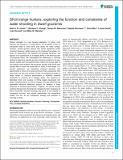Files in this item
Short range hunters : exploring the function and constraints of water shooting in dwarf gouramis
Item metadata
| dc.contributor.author | Jones, Nick A.R. | |
| dc.contributor.author | Klump, Barbara | |
| dc.contributor.author | Abaurrea, Teresa | |
| dc.contributor.author | Harrower, Sophie | |
| dc.contributor.author | Marr, Clare | |
| dc.contributor.author | Scott, Louise | |
| dc.contributor.author | Rendell, Luke | |
| dc.contributor.author | Webster, Mike | |
| dc.date.accessioned | 2021-12-23T13:30:13Z | |
| dc.date.available | 2021-12-23T13:30:13Z | |
| dc.date.issued | 2021-12 | |
| dc.identifier | 276860467 | |
| dc.identifier | 816d7bb8-9e29-4fbb-b730-a00c6f9b7cda | |
| dc.identifier | 85122375365 | |
| dc.identifier | 000738259300011 | |
| dc.identifier.citation | Jones , N A R , Klump , B , Abaurrea , T , Harrower , S , Marr , C , Scott , L , Rendell , L & Webster , M 2021 , ' Short range hunters : exploring the function and constraints of water shooting in dwarf gouramis ' , Journal of Experimental Biology , vol. 224 , no. 24 , 243477 . https://doi.org/10.1242/jeb.243477 | en |
| dc.identifier.issn | 0022-0949 | |
| dc.identifier.other | ORCID: /0000-0002-1121-9142/work/105318183 | |
| dc.identifier.other | ORCID: /0000-0001-9597-6871/work/105318324 | |
| dc.identifier.other | ORCID: /0000-0002-6031-7507/work/105318567 | |
| dc.identifier.uri | https://hdl.handle.net/10023/24572 | |
| dc.description.abstract | Ballistic predation is a rare foraging adaptation: in fishes, most attention has focused on a single genus, the archerfish, known to manipulate water to shoot down prey above the water surface. However, several gourami species also exhibit apparently similar ‘shooting’ behaviour, spitting water up to 5 cm above the surface. In a series of experiments, we explored the shooting behaviour and aspects of its significance as a foraging ability in the dwarf gourami (Trichogaster lalius). We investigated sex differences in shooting abilities to determine whether gourami shooting is related to the sex-specific bubble nest manufacture where males mix air and water at the surface to form bubbles. We found that, actually, both sexes were equally able to shoot and could learn to shoot a novel target. In a second experiment, we presented untrained gouramis with opportunities to shoot at live prey and found they successfully shot down both fruit flies and crickets. Finally, we explored the effect of target height on shooting performance to establish potential constraints of shooting as a foraging ability. The frequency of attempted shots and success of hitting targets decreased with height, whereas latency to shoot increased. We also observed that repeatable individual differences account for variation in these measures of shooting performance. Together, our results provide evidence that gourami shooting has a foraging function analogous to that of archerfish. Gourami shooting may serve as an example of convergent evolution and provide opportunities for comparative studies into the, as yet unexplored, ecology and evolution of shooting in fishes. | |
| dc.format.extent | 9 | |
| dc.format.extent | 5514293 | |
| dc.language.iso | eng | |
| dc.relation.ispartof | Journal of Experimental Biology | en |
| dc.subject | Ballistic predation | en |
| dc.subject | Gourami | en |
| dc.subject | Shooting | en |
| dc.subject | Trichogaster lalius | en |
| dc.subject | Foraging adaptation | en |
| dc.subject | GC Oceanography | en |
| dc.subject | QH301 Biology | en |
| dc.subject | DAS | en |
| dc.subject | AC | en |
| dc.subject.lcc | GC | en |
| dc.subject.lcc | QH301 | en |
| dc.title | Short range hunters : exploring the function and constraints of water shooting in dwarf gouramis | en |
| dc.type | Journal article | en |
| dc.contributor.institution | University of St Andrews. School of Biology | en |
| dc.contributor.institution | University of St Andrews. School of Psychology and Neuroscience | en |
| dc.contributor.institution | University of St Andrews. Centre for Social Learning & Cognitive Evolution | en |
| dc.contributor.institution | University of St Andrews. Centre for Biological Diversity | en |
| dc.contributor.institution | University of St Andrews. Sea Mammal Research Unit | en |
| dc.contributor.institution | University of St Andrews. Marine Alliance for Science & Technology Scotland | en |
| dc.contributor.institution | University of St Andrews. Bioacoustics group | en |
| dc.identifier.doi | 10.1242/jeb.243477 | |
| dc.description.status | Peer reviewed | en |
This item appears in the following Collection(s)
Items in the St Andrews Research Repository are protected by copyright, with all rights reserved, unless otherwise indicated.

